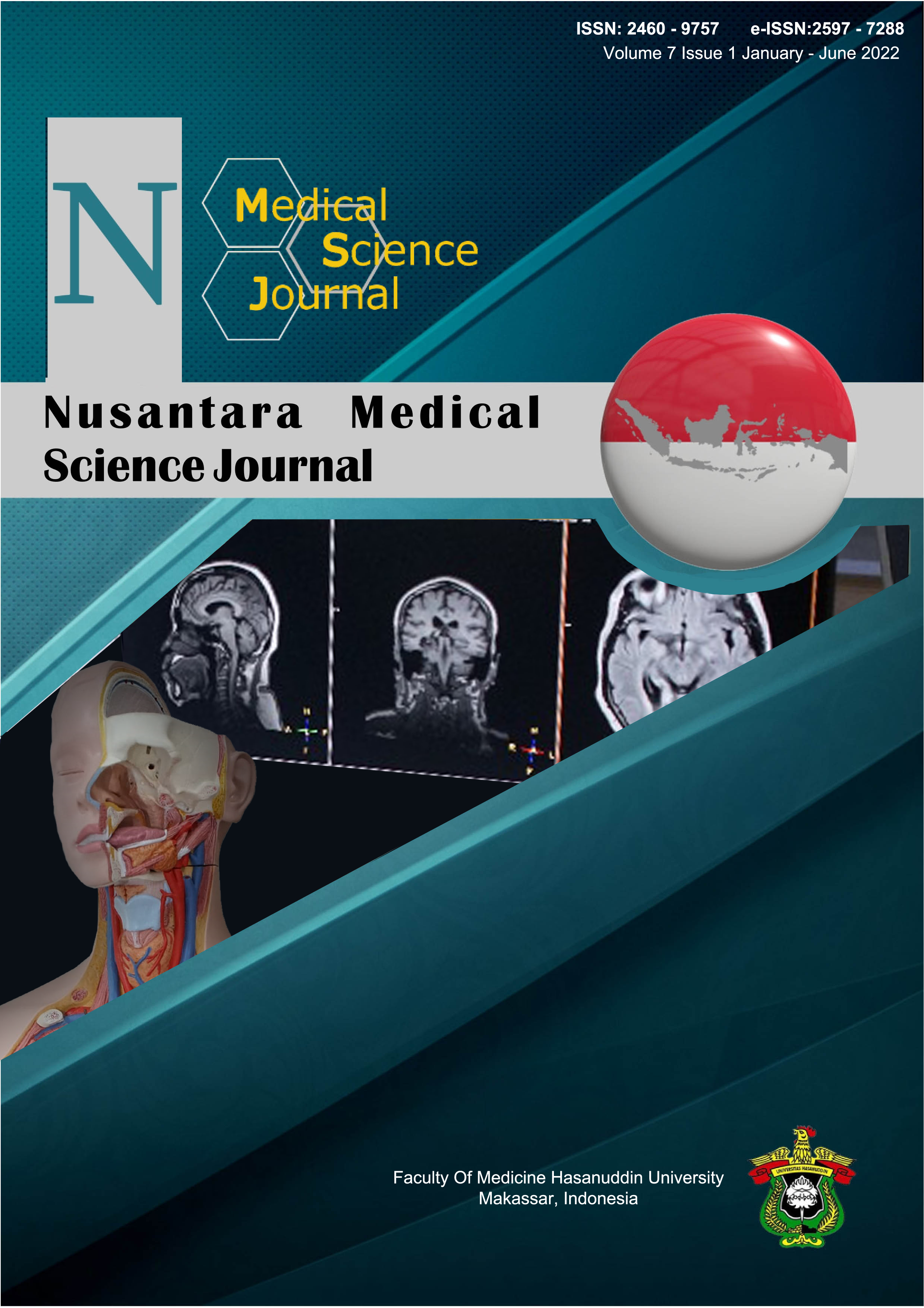The Examination of Olfactory Function and Mucocilliary Transport in Gas Station Officers in Makassar, Indonesia
DOI:
https://doi.org/10.20956/nmsj.v7i1.19233Abstract
Introduction: Chronic exposure to fuel oil can cause chemical burns to the olfactory epithelium, which can cause anosmia. This study aimed to compare mucociliary transport time and olfactory function between operator and non-operator officers at gas stations. Methods: This cross-sectional study was conducted from September to November 2020 and involved 40 subjects divided into two equal groups each consisting of 20 gas station operators and non-operators, respectively. The examination of mucociliary transport time was carried out by saccharin test, while the olfactory function was examined by assessing e olfactory threshold, discrimination, and identification (TDI) score using the Sniffin sticks test. Results: There was a significant difference in the mean mucociliary transport time and olfactory function between gas station operators and non-operators (P<0.001). In addition, there was also a significant correlation between the mucociliary transit time and olfactory function (p<0.05), with a strong negative correlation coefficient (r=-0.620). Therefore, the longer the mucociliary transit time, the gas station attendant's olfactory function will decrease. Conclusion: mucociliary transport time and olfactory function in non-operator public gas station officers were better than operators, probably because inhalation of chemical pollutants induces the release of proinflammatory cytokines, chronic inflammation of the nasal mucosa results in impaired olfactory cells and mucin glands.
References
Love K, Ahmed S. Olfactory dysfunction. BMJ. 2010;341.
Sobol S, Frenkiel S. Olfactory Dysfunction. Canadian Journal of Diagnosis. 2002:55.
Pinto JM, Thanaviratananich S, Hayes MG, Naclerio RM, Ober C. A genome-wide screen for hyposmia susceptibility loci. Chem Senses. 2008;33(4):319-29.
Fathoni A, Rianto B. Gangguan Penghidu Pada Pekerja Stasiun Pengisian Bahan Bakar Umum (SPBU) Di Yogyakarta [Olfactory Dysfunction Among Gas Station Workers in Yogyakarta]: PhD Thesis, Universitas Gadjah Mada; 2014.
Lynge E, Andersen A, Nilsson R, Barlow L, Pukkala E, Nordlinder R, et al. Risk of cancer and exposure to gasoline vapors. Am J Epidemiol. 1997;145(5):449-58.
Benson J, Barr E, Krone J. MTBE inhaled alone and in combination with gasoline vapor: uptake, distribution, metabolism, and excretion in rats. Research report (Health Effects Institute). 2001(102):73-94; discussion 5.
Lee CC, Chen MR, Shih TS, Tsai PJ, Lai CH, Liou SH. Exposure assessment on volatile organic compounds (VOCs) for tollway station workers via direct and indirect approaches. Journal of Occupational Health. 2002;44(5):294-300.
Doty RL. Chapter 17 - Neurotoxic exposure and impairment of the chemical senses of taste and smell. In: Lotti M, Bleecker ML, editors. Handb Clin Neurol. 131: Elsevier; 2015. p. 299-324.
Doty RL, Hastings L. Neurotoxic exposure and olfactory impairment. Clin Occup Environ Med. 2001;1:547-75.
Al-Saggaf SM, Shaker S, Ayuob NN, Al-Jahdali NH, Abdel-Hamid GA. Effect of car fuel (gasoline) inhalation on trachea of guinea pig: light and scanning microscopic study under laboratory conditions. J Anim Vet Adv. 2009;8(11):2118-24.
Smith CG. Age incidence of atrophy of olfactory nerves in man. A contribution to the study of the process of ageing. J Comp Neurol. 1942;77(3):589-95.
Doty RL, Kamath V. The influences of age on olfaction: a review. Front Psychol. 2014;5:20.
Bustamante-Marin XM, Ostrowski LE. Cilia and mucociliary clearance. Cold Spring Harb Perspect Biol. 2017;9(4):a028241.
Gudis D, Zhao K-q, Cohen NA. Acquired cilia dysfunction in chronic rhinosinusitis. American journal of rhinology & allergy. 2012;26(1):1-6.
Riechelmann H. Cellular and molecular mechanisms in environmental and occupational inhalation toxicology. GMS current topics in otorhinolaryngology, head and neck surgery. 2004;3.
Sénéchal H, Visez N, Charpin D, Shahali Y, Peltre G, Biolley J-P, et al. A review of the effects of major atmospheric pollutants on pollen grains, pollen content, and allergenicity. The Scientific World Journal. 2015;2015.
Downloads
Published
How to Cite
Issue
Section
License
Copyright (c) 2022 Nusantara Medical Science Journal

This work is licensed under a Creative Commons Attribution 4.0 International License.









